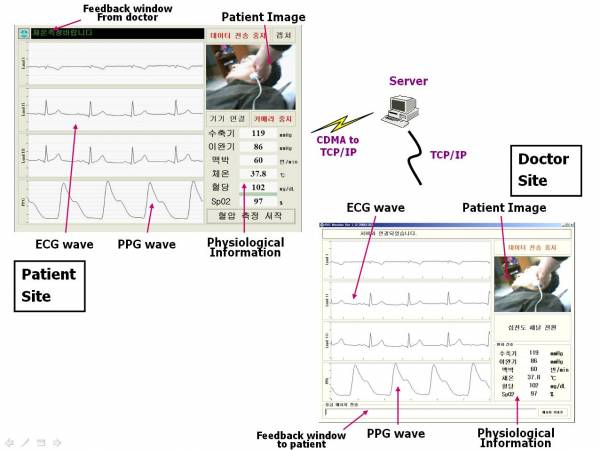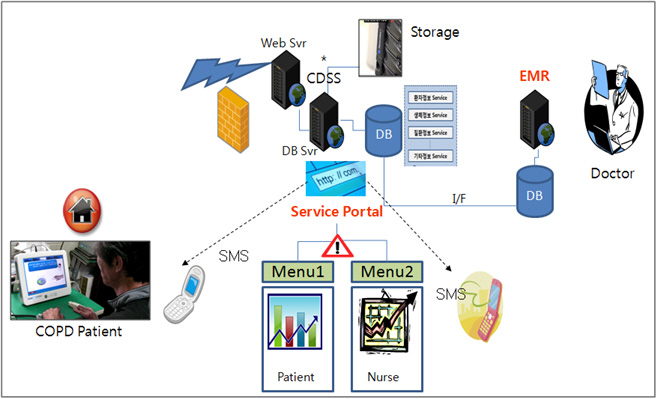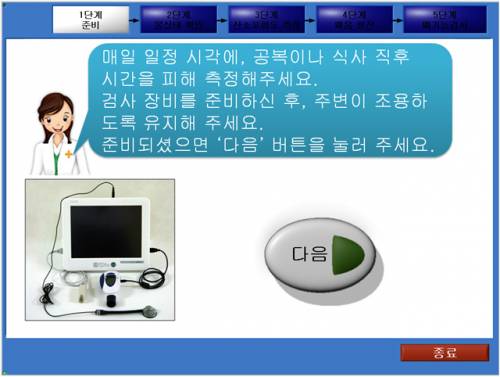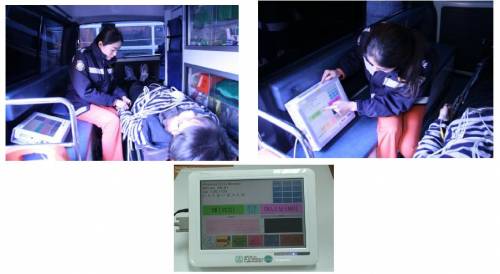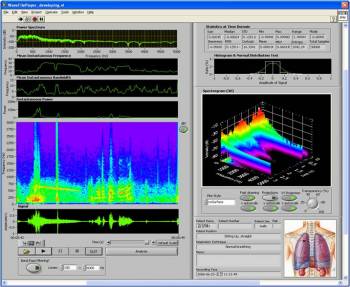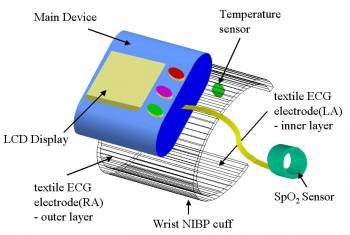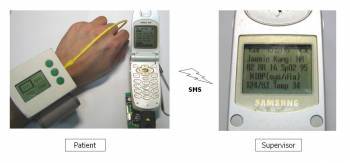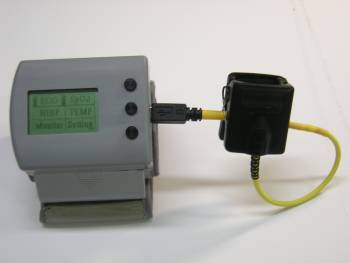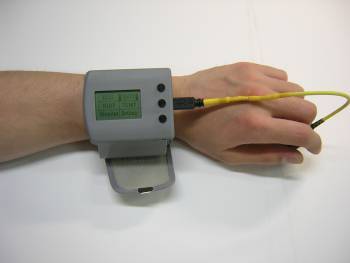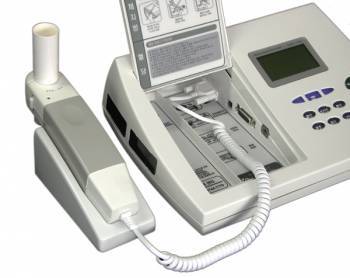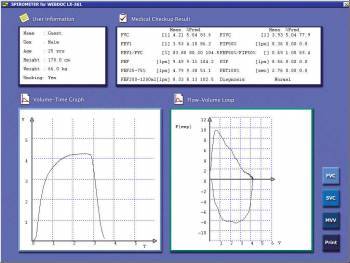U-Healthcare
Ubiquitous computing integrates computation into the environment, rather than having computers which are distinct objects. Promoters of this idea hope that embedding computation into the environment and everyday objects would enable people to interact with information-processing devices more naturally and casually than they currently do, and in ways that suit whatever location or context they find themselves in.
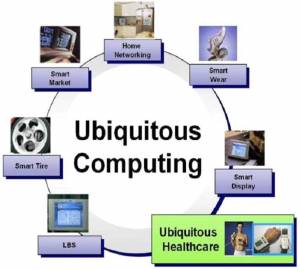
<Application of Ubiquitous computing>
Ubiquitous Healthcare is the delivery of health related services and information via ubuquitous computing technologies. It may be as simple as two health professionals discussing a case over the telephone, or as sophisticated as using satellite technology to broadcast a consultation between providers at facilities in two countries, using videoconferencing equipment or robotic technology. Ubiquitous Healthcare is an expansion of the functionality Telemedicine and it encompasses Preventive, Promotive and curative aspects. In our lab, there are various topic about ubiquitous healthcare.
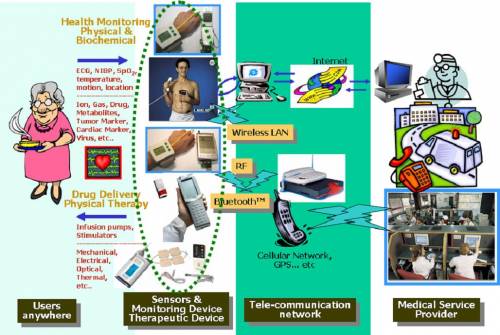
<Concept of Ubiquitous Healthcare>
Ongoing Project
CETS(CDMA based Emergency Telemedicine System)
The system was designed to be used by emergency rescuers to obtain guidance from emergency doctors for the provision of first-aid treatment in an ambulance setting. In the developed prototype system, the measured and transmitted vital information consists of physiological waveforms and variables, namely, a 6-channel ECG, blood pressure, oxygen saturation level, blood glucose level , body temperature , electrolyte analysis , patient image and GPS information. Measured patient data is transferred to a doctor’s PC through CDMA and TCP/IP networks using an embedded CDMA modem. After performance tests on a laboratory bench, the developed system was evaluated in real emergency situations on Jeju Island over a 2 month period (July 1, 2005~ August 30, 2005). By using performance tests on operating ambulances and by surveying participants,
As results of the performance evaluation and its application to real emergency situations, we confirm the efficacy of the devised CETS. The advantages of the described CDMA-based data transmission model include the rapid and safe transmission of measured data without time or space restriction. CDMA networks now cover practically all of Korea because they are used to provide cellular phone services. Since the CDMA telecommunication is based on an ad-hoc networking technology, one can connect to these networks anywhere and at anytime, so literally ubiquitous emergency healthcare service is possible.
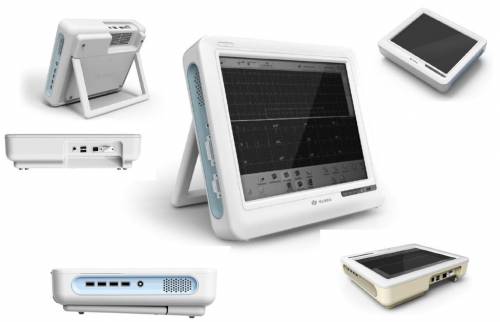
<New Multi-functional Platform Device: Wirelss Comm. using WIBRO >
COPD U-healthcare
Background
Chronic obstructive pulmonary disease (COPD) refers to chronic bronchitis and emphysema, a pair of two commonly co-existing diseases of the lungs in which the airways become narrowed. This leads to a limitation of the flow of air to and from the lungs causing shortness of breath. In contrast to asthma, the limitation of airflow is poorly reversible and usually gets progressively worse over time.
COPD is caused by noxious particles or gas, most commonly from smoking, which trigger an abnormal inflammatory response in the lung. The inflammatory response in the larger airways is known as chronic bronchitis, which is diagnosed clinically when people regularly cough up sputum. In the alveoli, the inflammatory response causes destruction of the tissues of the lung, a process known as emphysema. The natural course of COPD is characterized by occasional sudden worsenings of symptoms called acute exacerbations, most of which are caused by infections or air pollution.
Worldwide, COPD ranked sixth as the cause of death in 1990. It is projected to be the third leading cause of death worldwide by 2020 due to an increase in smoking rates and demographic changes in many countries. COPD is the 4th leading cause of death in the U.S., and the economic burden of COPD in the U.S. in 2007 was $42.6 billion in health care costs and lost productivity.
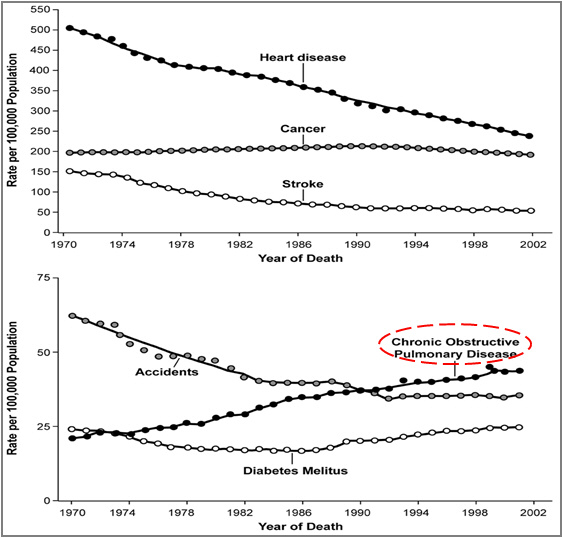
<COPD Prevalence: Only COPD has been increasing steadily since 1970 [Jemal A. et al. JAMA 2005]>
Goal
- Grading of COPD patient status using data from several sensor instruments
- Notifying when go to hospital
H/W
- Multi-functional Platform Device
- Touch Screen LCD, Wireless & Wired LAN, Battery Power
- Sensor Modules
- Pulse Oximeter: SpO2, Heart Rate
- Electronic Stethoscope: Lung & Heart sounds
- Spirometer: PEF(Peak Expiratory Flow), FEV1(Forced Expiratory Volume in 1 second)
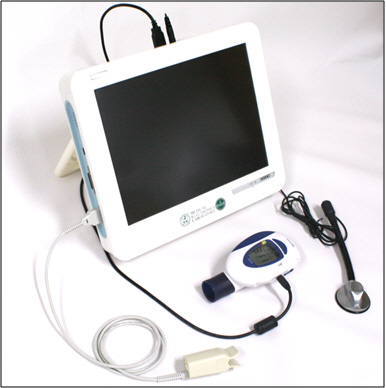
<Developed COPD Platform Device & Sensor Modules(Pulse Oximeter, Electronic Stethoscope, Spirometer)>
S/W
- UI
- Text instruction with voice narration
- Examinations
- Checking subjective health condition
- SpO2 and Heart Rate: after resting time (30 seconds)
- Lung sound auscultation for 6 locations on chest: 20 seconds at each location
- FEV1 and PEF: 3 times (examination interval is 30 seconds)
U-Emergency Healthcare System
Portable Breast Self Examination System
Past Projects
Wireless Pulse Oxymeter
Pulse oximetry is a simple non-invasive method of monitoring the percentage of haemoglobin (Hb) which is saturated with oxygen.
The pulse oxymeter works by following principle. A source of light originates from the probe at two wavelengths (650nm and 805nm). The light is partly absorbed by haemoglobin, by amounts which differ depending on whether it is saturated or desaturated with oxygen. By calculating the absorption at the two wavelengths the processor can compute the proportion of haemoglobin which is oxygenated. The oximeter is dependant on a pulsatile flow and produces a graph of the quality of flow. Where flow is sluggish (eg hypovolaemia or vasoconstriction) the pulse oximeter may be unable to function. The computer within the oximeter is capable of distinguishing pulsatile flow from other more static signals (such as tissue or venous signals) to display only the arterial flow.
The general pulse oximeter consists of a probe attached to the patient's finger or ear lobe which is linked to a computerised unit. The pulse oximeter is very important medical instrument for monitoring patients' status and their emergency states in hospital. Almost patients who have disease related by respiratory disorder or pulmonary heart disoder are equipped pulse oxymeter by hospital staffs. However in their house don't the patients get a similar medical service because general pulse oxymeter is so expensive and has too huge size that needs large space to be equipped. So in our reseach, we are developing a wireless pulse oxymeter that has many features like using wireless networking, collecting GPS data for patient tracking, portabliilty, relatively cheaper cost and etc.
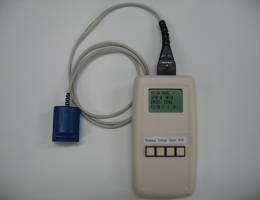
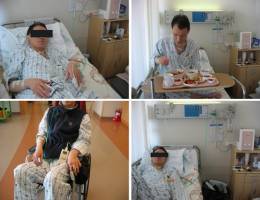

<Prototype Device using BluetoothTM module>
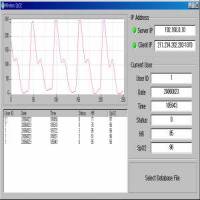
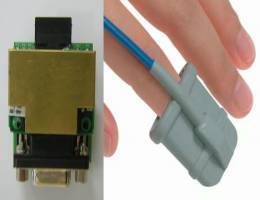
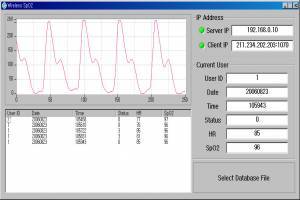
<Prototype Device using PDA with CDMA module and GPS module>
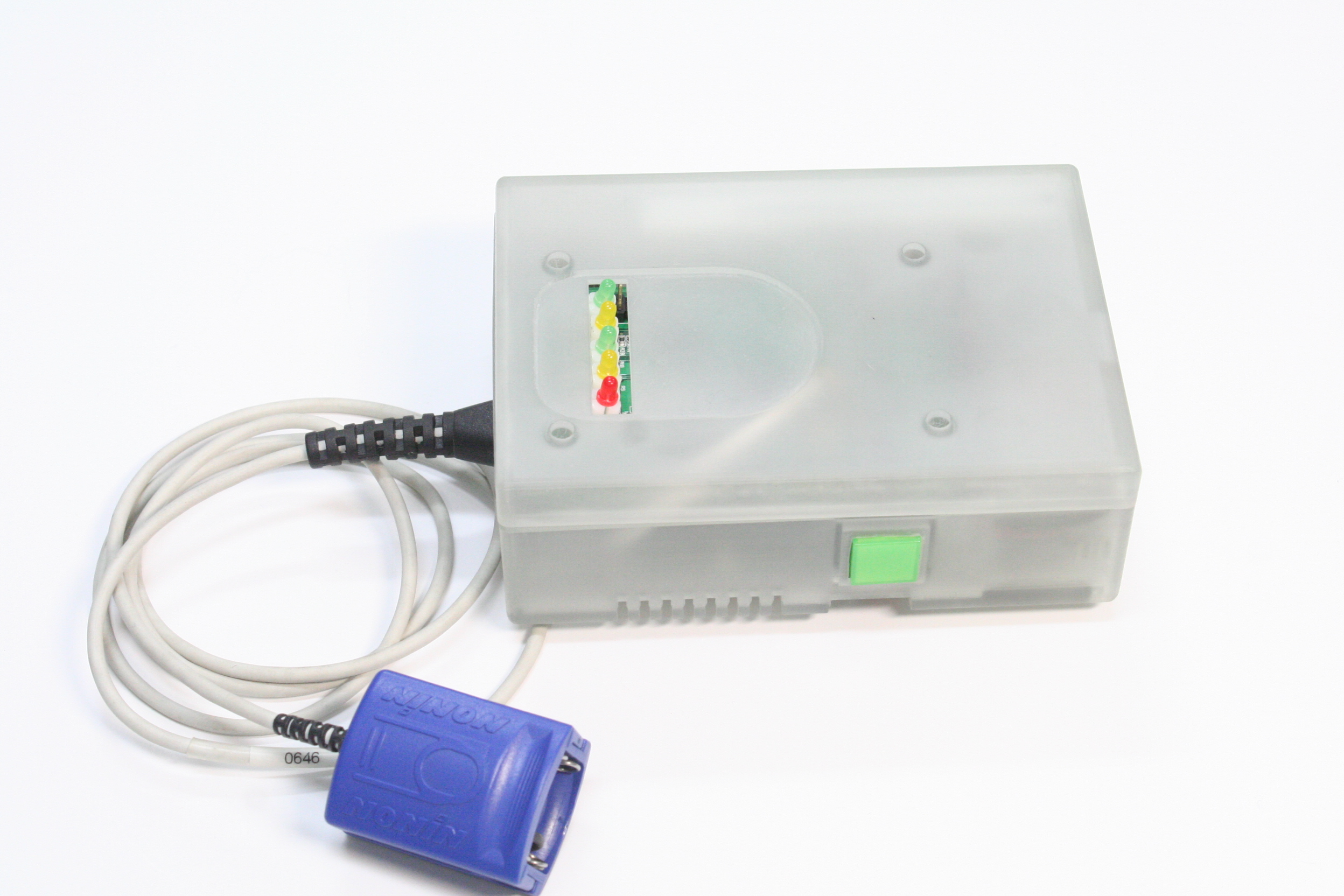
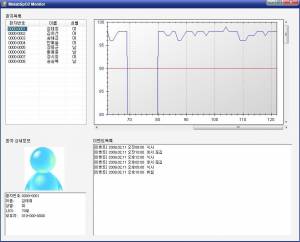
<Current Device using HSDPA modem and User Interface with Server>
Electronic Stethoscope
Our goal is development of u-healthcare system that is capable of acquiring, transferring and analyzing respiratory sounds of patients using electronic stethoscope. The system amplifies and visualize the respiratory sound, and improves the auscultation accuracy by revealing what cannot be easily heard contrary to a conventional stethoscope. Through signal processing and statistical methods, the sound is quantitatively analyzed and subjective assessment is replaced. Moreover tracking patient's status over time is available.
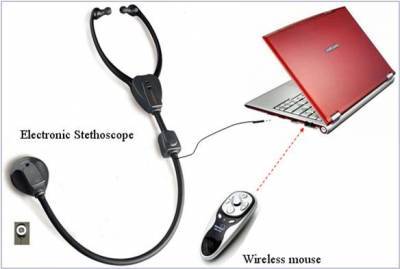
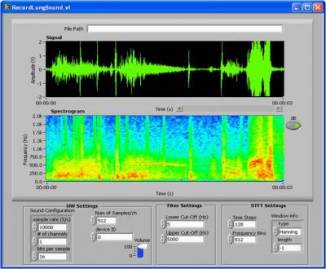
<Electronics Stethoscope & Recording S/W>
After auscultation, the respiratory sound data is transferred to the DB server trough TCP-IP and accessed by remote doctor-side program. The data are analyzed by power spectrum, spectrogram, mean instantaneous frequency, mean instantaneous bandwidth, instantaneous power, and 1st order statistics
Wrist-worn integrated health monitoring device
We have developed the prototype of a wrist-worn integrated health monitoring device (WIHMD) with a tele-reporting function for emergency telemedicine and home telecare for the elderly. The WIHMD consists of six vital biosignal measuring modules, which include a fall detector, a single channel electrocardiogram (ECG), and non-invasive blood pressure (NIBP), pulse oximetry (SpO2), respiration rate and body surface temperature measuring units. The size of the WIHMD is 60x50x20mm excepting the wrist cuff and the total system weighs 200g including two 1.5V AAA-sized batteries.
The functional objective of the WIHMD is to provide information concerning current condition, such as vital biosignals and locational information, with compromised fidelity to experts at a distance through the commercial cellular phone network. The developed system will provide the facility for rapid and appropriate directions to be given by experts in emergency situations, and enables the user or a caregiver to manage changes in health condition with helpful treatment.
Portable Spiromter
Spirometer is a device to evaluate the human ventilatory function by sensing and analyzing the respiratory air flow rate. Spirometric test is performed for both patients and ordinary people to evaluate health examination or lung function impairment.
In the present study, we developed a portable spirometer system that can be used either by professionals as a portable medical device or by individuals at home as a health care aid. It consists of a flow tube(paper mouthpiece) and the main signal processing unit. Specially designed pitot tube named sensing rod installed in the disposable flow tube provided the sensor mechanism, while the main processing unit performed necessary arithmetic operations as well as system control.
The system performance was evaluated through using the standard 3L calibration syringe and operating by human subjects in connection with both a PC and the WebDoc, a commercial home healthcare platform. Test results confirms the possibility of the developed system’s usage as a professional medical device as well as a home health care aid for the respiratory diseased patients.

